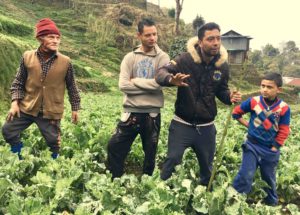Study tours help sustainable development professionals witness globally relevant challenges and innovations. Most recently I was leading a CLiGS study tour in India, where teachable moments abound. India’s development trajectory will likely be the most significant in human history and thus the most consequential for global sustainability challenges. Take urbanization. India is set to be fastest urbanizing country in history: a new New York City built every year to accommodate the rural to urban migration. The strain on urban infrastructure is intense: construction is continuous and haphazard; building codes, property rights, and zoning are lightly or unenforced in exchange for speed and volume; congestion and pollution are crippling health and productivity; informal settlements where new migrants are forced to live often lack water, sanitation, and transportation to jobs; and strong-arm tactics by unscrupulous developers and water mafia intimidate the weak and vulnerable. Still, people continue to migrate from rural to urban areas. Why?
Historically, urban areas provide better access to mates, education, healthcare, human rights, and higher paying jobs. Rural areas tend to be remote, conservative, underserviced by hospitals and schools, and require working in agriculture, which in India means long hours of manual labor for subsistence or poverty wages.
My students and I typically visit several livelihood development NGOs that target rural people. The leaders and professionals of these organizations never fail to impress and typically awe me and my students with their leadership chops, deep expertise, compassion, and their ability to straddle traditional and modern cultures. The learning opportunities for students are profound and local professionals are generous with their time.
But here is the dilemma I wrestle with: the livelihood development projects we study clearly and markedly improve quality of life in rural people, that’s clearly a good thing, but do they also just delay eventual urban migration and prolong patriarchal oppression and manual labor of disempowered people (esp., women)? That is, are the countless rural livelihood development efforts around the world unwisely enticing people to linger in rural villages by modestly improving their education and healthcare, by increasing access to fresh water, and by helping them market farm goods and traditional crafts? Should we instead be investing in improving urban migration and urban conditions?
Here is a fascinating example of the dilemma. The Sunderbuns is a heavily populated, biologically rich, World Heritage Mangrove wetland located in eastern India near Kolkata. Farms produce rice, vegetables, shrimp, crabs, and fish. Most of the farmers live in poverty: above horrible 2-dollar day abject poverty but many still have mud floors and lack key indicators of having entered the global middle class (washing machines or motorized transport such as a motorcycle).
Amarkhamar is one of the many impressive organizations working in the Sunderbuns to improve rural livability. They developed a software platform that allows farmers, mostly women, to sell directly to urban foodies. The result empowers women to bypass middleman who previously could scam and set the price because they had the advantage of better transportation and information. Now, the women know the price of rice and can work through Amarkhamar to sell directly to wealthy urban Indians who care about where their rice comes from and are willing to pay a price differential for distinctive heritage rice flavors and organic production. My students interviewed several of the women farmers and the empowerment and added wealth we witnessed were impressive. The extra income changes family dynamics and empowers women to help their families save for children education and other middle-class purchases. Because the rice is certified organic, the women report health benefits from not having to employ pesticides in the crops near where they work and live. They also report stable rice yields and lower cost of inputs (chemicals and fertilizer), making family finance more resilient to rice price fluctuations and crop failures.
Unfortunately, the income bump, while significant for those living near the poverty line, is marginal by middle-class standards—several hundred dollars a year. Moreover, the Sundarbans could be underwater in 100 years due to climate change and sea level rise. Farmers already see rising water, more flooding, rapidly declining aquifers from where their fresh water is pumped, and saltwater intrusion into those aquifers.
Should society encourage innovative and noble efforts such as Amarkhamar’s that help people stay in place and measurably improve their lives? Or, should we instead focus our innovative and talented people and organizations on hastening and improving urban migration and city retreat from rising sea levels?
